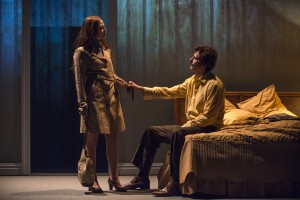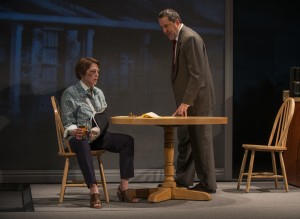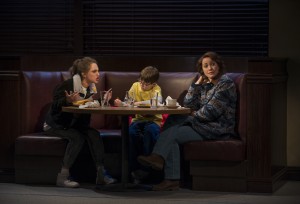PUZZLE PIECES OF A PERSON
Snapshots from a family album, jump cuts from a movie, scattered entries from a constant journal’”it’s hard to get a fix on Mary Page Marlowe, a very different offering from Tracy (August: Osage County) Letts. It’s enthralling too–because this new memory play from Steppenwolf Theatre Company, captivatingly captured by Artistic Director Anna D. Shapiro, reduces (or enlarges, as you like it) one woman’s life to fragments, telling scenes enacted by a large cast. Strangely and sweetly, they seem to sum up a life by scrambling it into a series of selves.
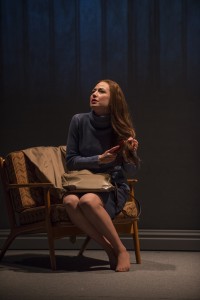 Any synopsis that offers a chronological plot summary would vandalize this jigsaw puzzle of a one act, though the order of scenes seems far from ordinary. Six actresses’”Blair Brown, Carrie Coon, Laura T. Fisher, Caroline Heffernan, Annie Munch and Rebecca Spence–play the title character at all ages and in many crises. Twelve other performers, including company members like Ian Barford and Alan Wilder, take part in equally terse hit-and-run vignettes. (The others are Stephen Cefalu, Jr., Amanda Drinkall, Jack Edwards, Kirsten Fitzgerald, Tess Frazer, Keith D. Gallagher, Sandra Marquez, Ariana Venturi, Madeline Weinstein and Gary Wilmes.) These slices of her life cumulatively create a composite of Mary Page Marlowe Gilbert–wife, mother, adulteress, three-time DUI arrestee, state prisoner, drunk, psychiatric patient, and, finally, a terminal but resigned body in a bed–none of it necessarily in order of importance.
Any synopsis that offers a chronological plot summary would vandalize this jigsaw puzzle of a one act, though the order of scenes seems far from ordinary. Six actresses’”Blair Brown, Carrie Coon, Laura T. Fisher, Caroline Heffernan, Annie Munch and Rebecca Spence–play the title character at all ages and in many crises. Twelve other performers, including company members like Ian Barford and Alan Wilder, take part in equally terse hit-and-run vignettes. (The others are Stephen Cefalu, Jr., Amanda Drinkall, Jack Edwards, Kirsten Fitzgerald, Tess Frazer, Keith D. Gallagher, Sandra Marquez, Ariana Venturi, Madeline Weinstein and Gary Wilmes.) These slices of her life cumulatively create a composite of Mary Page Marlowe Gilbert–wife, mother, adulteress, three-time DUI arrestee, state prisoner, drunk, psychiatric patient, and, finally, a terminal but resigned body in a bed–none of it necessarily in order of importance.
Almost forensically, we have to reconstruct M.P.M.’s life from pieces of the play (bearing in mind that almost as many are missing). They stretch from the ’40s to presumably the present. Mary Page Marlowe (her maiden name) emerges as a wife who, moving from Dayton, Ohio to Lexington, Kentucky and back, experienced or endured three husbands and at least one divorce. Along that way she had two kids. She enjoyed solving tax problems as a CPA, even more an affair with her boss. She may well have been an alcohol and drug abuser, doing time for running over an old man (and recording an astonishing .32 blood-alcohol reading).
Among this parade of turning points and ordinary events (perfectly illustrated by Todd Rosenthal’s shifting sets), her kids gave her the usual nightmare challenges ’” adolescent rebellion, ADD, resistance to moving out of state, running away, drug overdoses ’” though daughter Wendy gradually becomes a nurturing and steadying influence on her errant mother. Mary’s dad, a veteran of World War II, fought with her mom, just as she would with her spouses. In college her chums read Tarot cards and find both hope, adventure and death in Mary’s future (and, predictably, they were right). She discourages her eager-to-please son from singing at a school assembly. Images of the moon create a kind of metaphorical counterpoint to the goings-on.
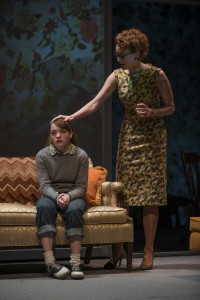 In the final scene, set in a laundromat, the second oldest version of M.P.M. comments on a family heirloom’”a vintage Victorian quilt with one panel that reveals a smudged image of a forgotten woman. The play ends here, leaving the opening afternoon audience a bit bewildered. But that’s the point of this shape-shifting play: nothing stays. Life subtracts more than it adds up.
In the final scene, set in a laundromat, the second oldest version of M.P.M. comments on a family heirloom’”a vintage Victorian quilt with one panel that reveals a smudged image of a forgotten woman. The play ends here, leaving the opening afternoon audience a bit bewildered. But that’s the point of this shape-shifting play: nothing stays. Life subtracts more than it adds up.
The one through-line in Mary Page Marlowe references that mysterious panel. In almost all six of her incarnations this woman is wrestling with questions of identity that hinge on choices she makes and on whether she means them as she makes them. “Don’t tell me what I feel,” she exclaims (but it’s as much to herself as to others). Though she considers herself “unexceptional,” she refuses to be defined. A key line — “You are your own person” ’” both makes no sense at all and seems gospel. So does another: “You are not the person you are.” It doesn’t matter who says these lines ’” they apply to more than Mary.
Even with so many parts of M.P.M. unaccounted for, Letts hands us a lot of one life in just 80 minutes. Shapiro’s Steppenwolf staging excels at filling in blanks and suggesting others. The confluence of what Mary thinks she wants, what she might have been, and what she settled for creates an inevitably unresolvable mystery. The stuff we can’t control, it seems, makes us who we are just as much as any destiny we pretend to shape.
As pure oracle, the Tarot cards in the second scene carry as much weight as a psychiatrist’s inquiry over Mary’s frustrated fantasies. No life, Letts implies, can be fully explained, let alone ever summed up. For theatergoers used to clean plotlines, streamlined storytelling, and conclusive exposition Mary Page Marlowe will seem a quagmire built over a swamp, randomness gone rancid. But, like so many recent successes at Steppenwolf (Domesticated, Grand Concourse, Good People), it shakes up the stage and its spectators. That can never be bad. Here it’s damn good.
photos by Michael Brosilow
poster photo by Saverio Truglia
Mary Page Marlowe
Steppenwolf Theatre Company
Downstairs Theater, 1650 N Halsted St
ends on May 29, 2016
EXTENDED to June 5, 2016
for tickets, call 312.335.1650 or visit Steppenwolf
for more theater info, visit Theatre in Chicago

